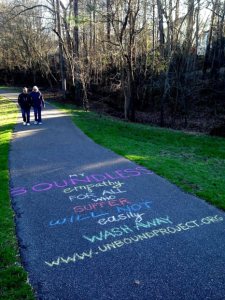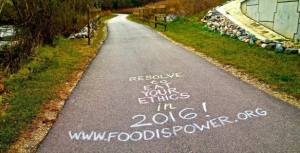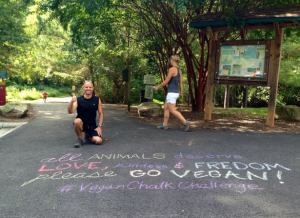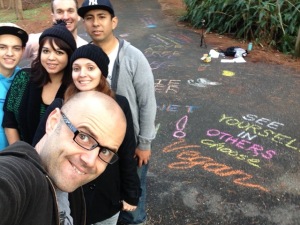Like many of us, animal activist James DeAlto always wanted to do something more. So he recently began chalking simple vegan and animal rights messages on public pathways and other prominent spots around his home in Raleigh, NC. The positive response from people on his “chalktivism” led James to launch the#VeganChalkChallenge, inspiring others to spread messages of compassion, peace, and hope. “This is not about creating a masterpiece,” James says, “it’s about fostering a sense of empowerment for activists who, like myself, are still apprehensive about wearing a vegan t-shirt for fear of ridicule or rejection.”
I caught up with James between chalkings to ask him about this unique form of activism—and how others can get involved.
What is the Vegan Chalk Challenge?
The Vegan Chalk Challenge is an idea that sprang out of the many positive experiences I had after I began writing vegan chalk messages in my own neighborhood and along nature paths in Raleigh. I decided to see if I could use social media to challenge others to do the same in their own community. So, I created a Facebook event with the goal of getting 100 other people to sign up. To my surprise, nearly 1,200 signed up. The overwhelming response has led me to wonder just how far we can take this as a movement.
What inspired you to use chalk in your activism?
For a long time, I had mostly been a student of the vegan/animal rights movement. I spent most of my time reading books,  scouring websites, desperately trying to convince friends and family to go vegan, having fruitless debates online, and not actually doing much real-world activism. I felt guilty for not doing more, so I started to think about ways that I could incorporate simple, effective activism into my everyday life.
scouring websites, desperately trying to convince friends and family to go vegan, having fruitless debates online, and not actually doing much real-world activism. I felt guilty for not doing more, so I started to think about ways that I could incorporate simple, effective activism into my everyday life.
I walk my dogs every day on a paved greenway where there’s quite a few walkers, runners and bikers. I figured it would be simple enough to write a vegan message on the pavement. So, I bought a box of chalk and did just that. I began posting pictures on Facebook and the response I got was amazing. People absolutely loved what I was doing.
I was motivated to keep going with my “chalktivism” largely because my messages seem to offer a sense of validation in a world where the word “vegan” often carries a stigma. Putting my chalk messages out there gives me a sense of empowerment. It allows me to stand up for animals in a way that minimizes the emotional risk, while still giving me the satisfaction of knowing that what I’m doing is effective.
What kinds of responses are you getting from people who see these messages?
My neighbors and people I meet tell me they love what I’m doing. I’m sure there are some who aren’t thrilled with it, but I’ve only had one person ever tell me they didn’t like my messages. She was rather curmudgeonly and could only answer, “I like meat” when I asked what she didn’t like about it.
My next-door neighbor is a Trump supporter and a rabid meat-eater. He loves it. He always asks me when I’m going to do my next one. That tells me this works. Other people I regularly see on my walks tell me they take pictures and love the positive, creative messages I leave.
Why do you think this form of activism works?
 I’ve weighed out the costs/benefits of so many forms of activism and I find that chalking works for so many reasons.
I’ve weighed out the costs/benefits of so many forms of activism and I find that chalking works for so many reasons.
First, it’s simple. It requires so little time. I can literally write a message like “Vegan Is Love” in 15 seconds inside a busy parking deck and it will be seen by hundreds of people.
Second, it’s unexpected. Just seeing the word “vegan” in a public space, written as a personal, artistic expression of one’s beliefs, is unexpected and makes people curious. When people see these messages in nature, especially in parks or greenways, they’re in a headspace to actually contemplate the message, to discuss its merits with their walking partner or to reflect on a time when they may have previously been vegetarian or vegan. In parks and on greenways, the distractions are much fewer and because my messages are appearing in spaces where political expression is unexpected, the messages are memorable.
Third, it’s emotional. People who read my messages intuitively understand there’s an emotional element that inspired me to take action. People are interested in not only the message, but in the person behind the message. The mystery for those who haven’t yet figured out it’s me has become a very interesting aspect of this story which keeps people’s attention and leaves them interested to see what I’m going to write next.
Fourth, since it’s not an in-person solicitation, viewers are less likely to be defensive. Chalk is usually associated with childhood and people are naturally curious. My neighbors, when they find out it’s been me leaving the messages, have often told me they thought it was a little girl! Because I’m usually absent when people read the message, the focus is squarely on the words themselves, removing any negative bias the recipient may have otherwise had based on my appearance or body language.
Fifth, chalk messages lead to conversations. People have told me they’re thinking more about their food choices because of my actions. Knowing my audience is already concerned with health and environmental issues, I like to leave messages that will encourage them to talk about these particular issues. I’ll often use statistics from Cowspiracy with the message “Watch Cowspiracy on Netflix.” Or, I’ll write something health-related and write “Watch Forks Over Knives on Netflix.” If I can get people to watch these movies over a span of an hour and a half, I feel that’s a great payoff for taking a few minutes to write a chalk message.
Sixth, effective activism strengthens the vegan community. Public chalk messages offer other vegans a sense of validation. I have a vegan therapist who runs on the greenway where I leave my messages. She told me that the first time she saw one, she threw her arms up in the air and yelled, “Yes!” What we’re doing provokes a sense of excitement in “closet vegans,” offering the assurance there are others out there like themselves. This can go a long way toward normalizing veganism, which I think is one of our main tasks as a movement.
Seventh, the afterlife of a chalk message is much longer than what we leave on the pavement. When people post their pictures Facebook, the love and appreciation that pours out in the comments fuels my desire to go out and do more. When others post pictures of their own chalk messages and share their personal experiences, it makes my entire day. What’s most exciting is the growing community of activists who are starting to see the potential in what we’re doing. The Vegan Chalk Challenge has become an unfolding story, which makes it very exciting for me personally.
What other types of activism are you engaged in?
I’m a professional videographer and amateur photographer, so I sometimes lend my skills to our local animal sanctuaries, Piedmont Farm Animal Refuge, and Triangle Chance for All.
Piedmont Farm Animal Refuge, and Triangle Chance for All.
I also do a lot of online activism, helping new vegans find their footing and sharing valuable resources. I’ve found a good deal of success planting seeds with people who are already interested in things like environmental protection, compassion and concern for animals.
This year I founded a new group in Raleigh called “Vegans for Peace.” Our focus is on bringing people into the vegan community through the use of low-cost advertising like chalking, highway signs (like the ones you so often see for queen-sized mattresses) and leaflets. We’re finding new ways to get the vegan message out there via simple means we’ve not capitalized upon in the past.
I’ve started doing some community organizing as well. On February 13th, I’m organizing a “Vegan Moral March on Raleigh” as part of the much larger 10th-annual “Mass Moral March on Raleigh.” We’ll be marching alongside thousands of other progressives, bringing attention to the plight of nonhuman animals and the devastating human and environmental impacts of animal agriculture.
Do you see this form of activism catching on within the animal rights/vegan movement?
I see a lot of potential for this simple, creative form of resistance. If we were to do engage in this type of action with regularity and in big enough numbers, I believe there’s a lot we could accomplish.
I’m very drawn to the concept of collective action that will get these critical issues on the table as quickly as possible. I admire groups like Collectively Free who are building communities based on public disruptions of speciesism. We need collective actions that are newsworthy. In this sense, I believe collective chalking is very much worth considering. “Chalk-bombing” public spaces with positive vegan messages of hope, empathy, peace, and love could potentially get the media talking if we do it in big enough numbers. Like the ice-bucket challenge, it’s so innocuous and fun that we can likely get vegan celebrities to join us.
Another major advantage I see with chalking is that non-active vegans are more likely to join in. As opposed to other forms of activism, when I ask people to come out chalking with me, there’s rarely any hesitation. This is a simple, fun, unthreatening form of disruption that is very unexpected in public spaces. Entire families can come and have a good time doing it. There’s no need to organize or to discuss strategy or tactics. There’s nearly zero risk of getting into trouble. I think it’s a great look for our movement.
I feel confident this approach will, at the very least, get the issue on the pavement. With enough people doing it, I believe we could easily get the issue into mainstream discussion in a way that would be very interesting and inviting.
What advice do you have for other animal advocates who might like to use chalk messages in their activism?
 First, I would say don’t worry about messing up or if you don’t consider yourself a great artist. I’ve been told I have nice handwriting, but I’m hardly an artist. If you mess up, it doesn’t matter. The animals don’t care too much about penmanship or spelling. They just want us to speak out for them as loudly, as effectively and as often as possible.
First, I would say don’t worry about messing up or if you don’t consider yourself a great artist. I’ve been told I have nice handwriting, but I’m hardly an artist. If you mess up, it doesn’t matter. The animals don’t care too much about penmanship or spelling. They just want us to speak out for them as loudly, as effectively and as often as possible.
Second, I would recommend writing messages centered around empathy, compassion, kindness, love, mercy, hope, peace, etc. Non-vegans tell me they find my messages interesting and approachable even if they’re challenging. Also, parents are far more likely to complain if their kids are confronted with messages that imply meat-eaters are murderers, rapists, slave-owners, or Nazis.
Third, if you’re interested in trying this, work on ways to integrate it into your daily routine. It’s easy to forget and it does require developing a new habit. You might try keeping a box of chalk in your car and a Post-it note on your dashboard reminding you to write messages. If you’re a student, you might consider keeping a few pieces of chalk in a plastic baggy inside your backpack. If you’re a runner or a biker, it’s easy enough to carry some chalk with you when you hit the trails.
Fourth, figure out what you want to say ahead of time. This makes it easier and less stressful when you find the perfect spot to leave your message. If you’re not sure what to say, a simple message like “Vegan Is Love” is perfect.
Fifth, consider leaving a web link like www.freefromharm.com, which offers people a call to action. Many times, I’ll just write, “Watch Cowspiracy on Netflix” since Netflix is something people are already familiar with. This lends more credibility to the message. I’ve cultivated a list of messages that I feel are effective. I have them posted on our Vegan Chalk Challenge Facebook page for anyone interested.
Sixth, take pictures and video and share them on social media! This is perhaps as valuable as the messages themselves. The traction I get from posting pictures on Facebook and Instagram is what inspires others to go out and do the same. Images of people walking by and engaging with the message are especially effective. Videos of people expressing positive reactions are incredibly valuable. When taking pictures, try to take them from an angle that gives a good sense of the surroundings. For example, try to get a shot of the message along with the long empty pathway in the background.
Seventh, smooth pavement is much easier to write on.
Eighth, consider organizing a vegan chalk party as part of your local activist group’s regular activities. Going out with friends to do this is an effective way of strengthening community. You can all get out into nature together and help animals at the same time.
Ninth, don’t overthink it! The animals really don’t give a damn whether or not our chalk messages are museum-worthy. As with anything, practice and you’ll get better quickly. Unleash your creativity for animals! Be proud to take a bold stance!
Tenth, just have fun and enjoy the satisfaction of knowing your messages are making a difference!
Do check out James’ Vegan Chalk Challenge Facebook page for more information and inspiring photos.


Hi Mark,
Congratulations on the new book!I can’t wait to see you and Lauren in Portland at Herbivore, 8/27.OH, and read the book too!
We no longer have Resistance Ecology, which is sad to me.I miss networking with a variety of groups, but as Portland grows, so do the groups and people.I am still a board member for NW Veg and for years Vegan Iron Chef!
I had a question, perhaps ethical? The Good Food Institute is extracting cells from cows and pigs to grow lab meat.Do you have an opinion about this? You need not go into answering why;I understand that.Whether I agree or not.
Looking forward to You and Lauren.Hope all is well with you!
Cindy<3